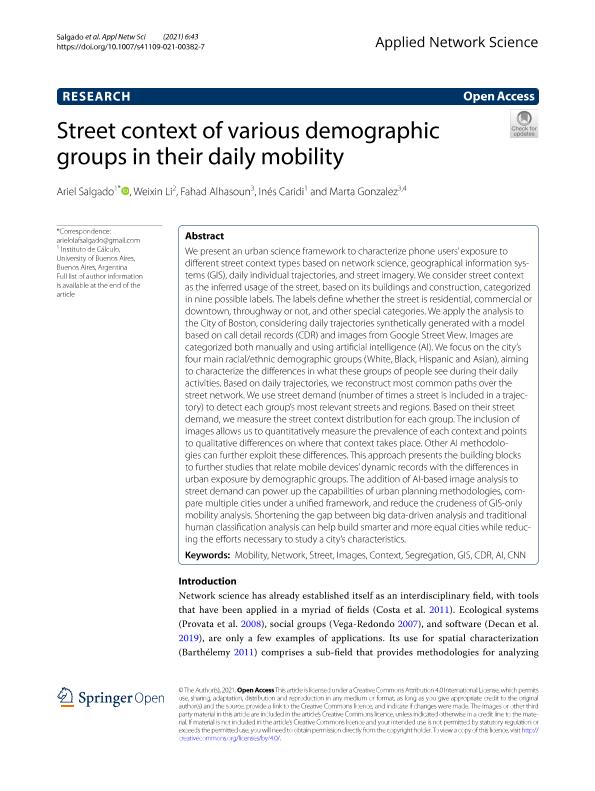Mostrar el registro sencillo del ítem
dc.contributor.author
Salgado Corrado, Ariel Olaf

dc.contributor.author
Li, Weixin
dc.contributor.author
Alhasoun, Fahad
dc.contributor.author
Caridi, Délida Inés

dc.contributor.author
Gonzalez, Marta

dc.date.available
2022-10-05T11:23:23Z
dc.date.issued
2021-06-12
dc.identifier.citation
Salgado Corrado, Ariel Olaf; Li, Weixin; Alhasoun, Fahad; Caridi, Délida Inés; Gonzalez, Marta; Street context of various demographic groups in their daily mobility; Springer; Applied Network Science; 6; 1; 12-6-2021; 1-14
dc.identifier.issn
2364-8228
dc.identifier.uri
http://hdl.handle.net/11336/171867
dc.description.abstract
We present an urban science framework to characterize phone users’ exposure to different street context types based on network science, geographical information systems (GIS), daily individual trajectories, and street imagery. We consider street context as the inferred usage of the street, based on its buildings and construction, categorized in nine possible labels. The labels define whether the street is residential, commercial or downtown, throughway or not, and other special categories. We apply the analysis to the City of Boston, considering daily trajectories synthetically generated with a model based on call detail records (CDR) and images from Google Street View. Images are categorized both manually and using artificial intelligence (AI). We focus on the city’s four main racial/ethnic demographic groups (White, Black, Hispanic and Asian), aiming to characterize the differences in what these groups of people see during their daily activities. Based on daily trajectories, we reconstruct most common paths over the street network. We use street demand (number of times a street is included in a trajectory) to detect each group’s most relevant streets and regions. Based on their street demand, we measure the street context distribution for each group. The inclusion of images allows us to quantitatively measure the prevalence of each context and points to qualitative differences on where that context takes place. Other AI methodologies can further exploit these differences. This approach presents the building blocks to further studies that relate mobile devices’ dynamic records with the differences in urban exposure by demographic groups. The addition of AI-based image analysis to street demand can power up the capabilities of urban planning methodologies, compare multiple cities under a unified framework, and reduce the crudeness of GIS-only mobility analysis. Shortening the gap between big data-driven analysis and traditional human classification analysis can help build smarter and more equal cities while reducing the efforts necessary to study a city’s characteristics.
dc.format
application/pdf
dc.language.iso
eng
dc.publisher
Springer

dc.rights
info:eu-repo/semantics/openAccess
dc.rights.uri
https://creativecommons.org/licenses/by/2.5/ar/
dc.subject
AI
dc.subject
CDR
dc.subject
CNN
dc.subject
CONTEXT
dc.subject
GIS
dc.subject
IMAGES
dc.subject
MOBILITY
dc.subject
NETWORK
dc.subject
SEGREGATION
dc.subject
STREET
dc.subject.classification
Otras Ingenierías y Tecnologías

dc.subject.classification
Otras Ingenierías y Tecnologías

dc.subject.classification
INGENIERÍAS Y TECNOLOGÍAS

dc.subject.classification
Otras Ciencias Físicas

dc.subject.classification
Ciencias Físicas

dc.subject.classification
CIENCIAS NATURALES Y EXACTAS

dc.title
Street context of various demographic groups in their daily mobility
dc.type
info:eu-repo/semantics/article
dc.type
info:ar-repo/semantics/artículo
dc.type
info:eu-repo/semantics/publishedVersion
dc.date.updated
2022-09-19T11:03:35Z
dc.journal.volume
6
dc.journal.number
1
dc.journal.pagination
1-14
dc.journal.pais
Suiza

dc.description.fil
Fil: Salgado Corrado, Ariel Olaf. Universidad de Buenos Aires. Facultad de Ciencias Exactas y Naturales. Instituto de Calculo. - Consejo Nacional de Investigaciones Científicas y Técnicas. Oficina de Coordinación Administrativa Ciudad Universitaria. Instituto de Calculo; Argentina
dc.description.fil
Fil: Li, Weixin. Massachusetts Institute of Technology; Estados Unidos
dc.description.fil
Fil: Alhasoun, Fahad. University of California at Berkeley; Estados Unidos
dc.description.fil
Fil: Caridi, Délida Inés. Universidad de Buenos Aires. Facultad de Ciencias Exactas y Naturales. Instituto de Calculo. - Consejo Nacional de Investigaciones Científicas y Técnicas. Oficina de Coordinación Administrativa Ciudad Universitaria. Instituto de Calculo; Argentina
dc.description.fil
Fil: Gonzalez, Marta. University of California at Berkeley; Estados Unidos
dc.journal.title
Applied Network Science
dc.relation.alternativeid
info:eu-repo/semantics/altIdentifier/doi/http://dx.doi.org/10.1007/s41109-021-00382-7
dc.relation.alternativeid
info:eu-repo/semantics/altIdentifier/url/https://appliednetsci.springeropen.com/articles/10.1007/s41109-021-00382-7
Archivos asociados
